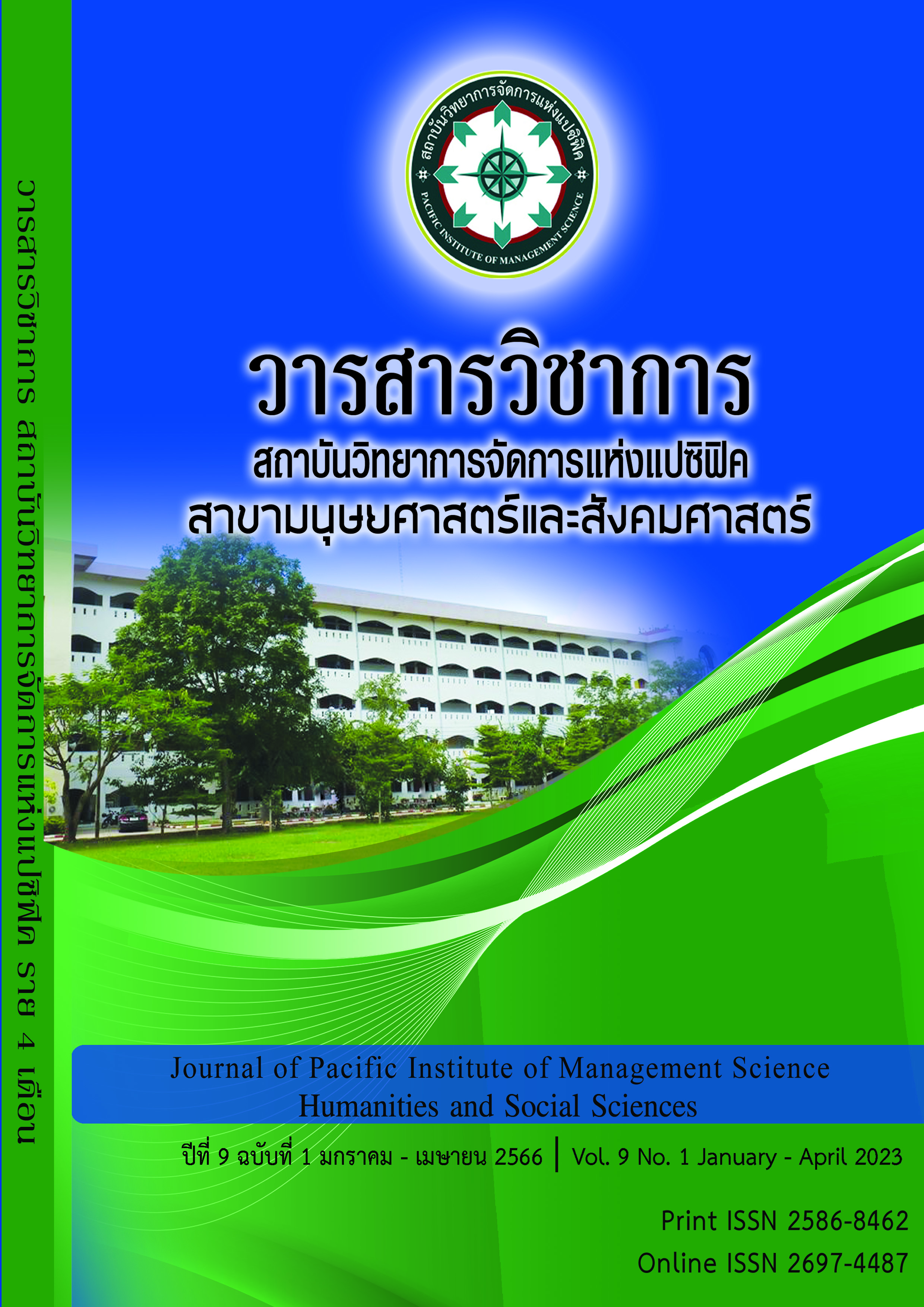Transformational Leadership of Subdistrict Administrative Organizations in Phra Pradaeng District, Samut Prakan Province
Keywords:
Leadership, Change, President, Subdistrict Administrative Organization, Samut Prakan ProvinceAbstract
The objectives of this study were: to study the transformational leadership of Subdistrict Administrative Organizations in Phra Pradaeng District, Samut Prakan Province, and to find guidelines to develop transformational leadership of Subdistrict Administrative Organizations in Phra Pradaeng District, Samut Prakan Province.
The population used in this study was staff and employees under Subdistrict Administrative Organization in Phra Pradaeng District, Samut Prakan Province, totaling 565 people, which was obtained by random sampling by determining, the sample group from the ready-made tables of Krejcie and Morgan, 228 people were sample. The tools used to collect data were questionnaires. The statistics used in data analysis were percentages, mean values, and standard deviation.
The results found that the transformational leadership of Subdistrict Administrative Organizations in Phra Pradaeng District, Samut Prakan Province, overall, the transformational leadership was moderate. and the guidelines to develop transformational leadership of Subdistrict Administrative Organizations in Phra Pradaeng District, Samut Prakan Province must develop leadership in all 4 aspects of change, namely: influencing with ideology; there should be a clear working process, used power appropriately, clear vision inspiring, should act as a good role model, having enthusiasm for work, seeing the benefits of the whole more than the individual had confidence in personnel, using positive communication , intellectual stimulation, should encourage employees to attend training, to attend various seminars, encourage employees to search for information from multiple sources, organizing a study visit to other agencies and the aspect of taking into account the individual, there should be special welfare arrangements for employee, assigning tasks according to their abilities, take close care of employees, accepting the individual differences.
References
กวี วงศ์พุฒ. (2550). ภาวะผู้นำ. กรุงเทพฯ: ศูนย์ส่งเสริมวิชาชีพบัญชี.
จรรยา ศิวานนท์. (2549). บทบาทของนายกองค์การบริหารส่วนตำบลในการพัฒนาท้องถิ่น อำเภอแม่วาง จังหวัดเชียงใหม่. เชียงใหม่: มหาวิทยาลัยเชียงใหม่.
ชนะดา วีระพันธ์. (2555). ความพึงพอใจของประชาชนต่อการให้บริการขององค์การบริหารส่วน ตำบลบ้านเก่า อำเภอพานทอง จังหวัดชลบุรี. ชลบุรี: มหาวิทยาลัยบูรพา.
ทองทิพภา วิริยะพันธุ์. (2550). ปัจจัยที่มีผลต่อการเพิ่มประสิทธิภาพการสื่อสารขององค์กรธุรกิจ. กรุงเทพฯ: มหาวิทยาลัยหอการค้าไทย.
นิรัตน์ สังข์จีน. (2553). ภาวะผู้นำการเปลี่ยนแปลงกับประสิทธิผลในการปฏิบัติงานของนายกเทศมนตรี: ศึกษาเฉพาะกรณี เทศบาลในจังหวัดปัตตานี. ภาคนิพนธ์ปริญญา มหาบัณฑิต สถาบันบัณฑิตพัฒนบริหารศาสตร์.
ประสิน วีระกุล. (2552). ภาวะผู้นำการเปลี่ยนแปลงกับประสิทธิผลการปฏิบัติงานของนายกองค์การบริหารส่วนตำบล: กรณีศึกษา องค์การบริหารส่วนตำบล อำเภอเมืองจังหวัดปทุมธานี. การศึกษาอิสระรัฐประศาสนศาสตรมหาบัณฑิต มหาวิทยาลัยขอนแก่น.
สยามพร พันธไชย. (2561). ภาวะผู้นำท้องถิ่นในศตวรรษที่ 21. วารสารวิชาการแพรวากาฬสินธุ์ 5(1) : 194-212.
สุภาวดี จิตติรัตนกุล. (2550). ภาวะผู้นำการเปลี่ยนแปลงกับประสิทธิผลการปฏิบัติงาน ของนายกเทศมนตรี กรณีศึกษา เทศบาลเมืองพังงา อำเภอเมือง จังหวัดพังงา. วิทยานิพนธ์ปริญญามหาบัณฑิต มหาวิทยาลัยขอนแก่น.
Bass, B. M., and Avolio, B. J. (1994). Improving Organizational Effectiveness through Transformational Leadership. Sage Publications, Inc.
Burns, J. M. (1978). Leadership. New York: Harper and Row.
Clarke, J. I. (1977). On the Classification of Population Types and Regions. National Geographer 12 : 131-6.
Huse, E. F. (1978). Organization Development and Change. 3rd ed. Mason, OH: Cengage/South-Western.
Krejcie, R. V., and Morgan, D. W. (1970). Determining Sample Size for Research Activities. Educational and Psychological Measurement 30(3) : 607-610.
McFarland, D. E. (1979). Management : Foundation & Practices. 5th ed. New York: Macmillan.
Mohsen, A., and Mohammad, R. D. (2011). Considering Transformational Leadership Model in Branches of Tehran Social Security Organization. Social and Behavioral Sciences 15 (2011): 3131-3137.
Mohsen, A., and Mohammad, R. D. (2011). Considering Transformational Leadership Model in Branches of Tehran Social Security Organization. Social and Behavioral Sciences 15 : 3131-3137.
Mosley, D. C. et al. (1996). Management Concept and Practices. New York: Harper-Collins.
Mushinsky, P. M. (1997). Psychology Applied to Work an Introductions to Industrial and Organizational Psychology. California: Brooks/Cole.
Yukl, G. (1989). Managerial Leadership: A Review of Theory and Research. Journal of Management 15(2) : 251–289.
Downloads
Published
Issue
Section
License
Copyright (c) 2023 Pacific Institute of Management Science

This work is licensed under a Creative Commons Attribution-NonCommercial-NoDerivatives 4.0 International License.
บทความที่ได้รับการตีพิมพ์เป็นลิขสิทธิ์ของ สถาบันวิทยาการจัดการแห่งแปซิฟิค
ข้อความที่ปรากฏในบทความแต่ละเรื่องในวารสารวิชาการเล่มนี้เป็นความคิดเห็นส่วนตัวของผู้เขียนแต่ละท่านไม่เกี่ยวข้องกับสถาบันวิทยาการจัดการแห่งแปซิฟิค และคณาจารย์ท่านอื่นๆในสถาบันฯ แต่อย่างใด ความรับผิดชอบองค์ประกอบทั้งหมดของบทความแต่ละเรื่องเป็นของผู้เขียนแต่ละท่าน หากมีความผิดพลาดใดๆ ผู้เขียนแต่ละท่านจะรับผิดชอบบทความของตนเองแต่ผู้เดียว







